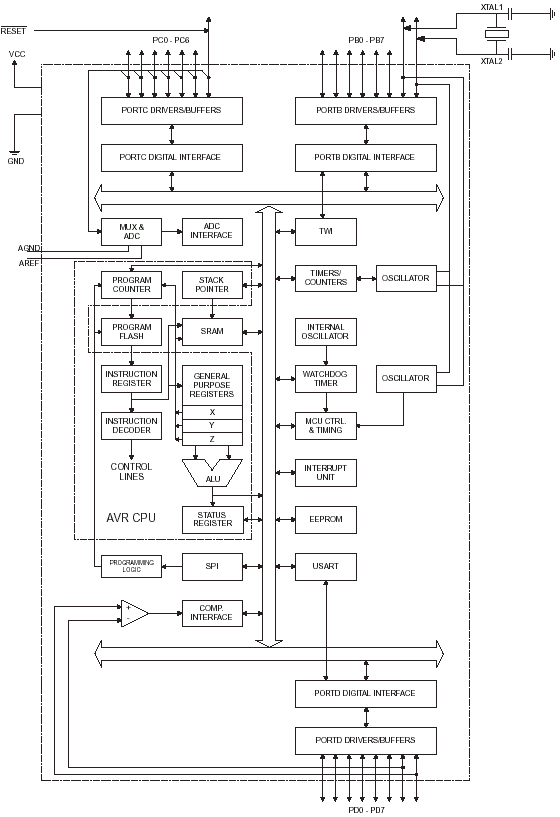Atmega8 Datasheet Na Russkom

My Arduino Uno has a ATMEGA328P-PU microcontroller, and bunch of other stuff on the board. I'd like to program the chip without the Arduino software, and only the minimum of other components.
ATmega8A Data Sheet Introduction The ATmega8A is a low-power CMOS 8-bit microcontroller based on the AVR® enhanced RISC architecture. By executing powerful instructions in a single clock cycle, the ATmega8A achieves throughputs close to 1 MIPS per MHz. This empowers system designer to optimize the device for power consumption versus processing. Obrazets_otzyva_na_iskovoe_zaiavlenie_v_arbitrazhnyi_sud_obrazets, 600999,.
I want to eventually create things without the cost of Arduino, and I want to learn about the other parts on the board and add them back as as needed. I'm comfortable with C and gcc, so I can probably figure out the software part. But what, if anything, besides these two products below, do I need to have in the breadboard with the microcontroller?
$ begingroup $ @capcom First google result for 'site:atmel.com atmega typical application' finds. Not only does this application note have a minimal circuit to get the MCU to work, it goes in to great detail on how to connect a programming port, select oscillators, deal with ESD hazards, potential glitches on the reset line, connecting JTAG, PCB layout, and basically everything a beginner needs.
Finding this information is the most useful skill a beginner can have. $ endgroup $ – Jan 15 '13 at 3:38 •. $ begingroup $ OK, I'll rehprase.
Rob, you should know that any manufacturer of a non-trivial device will publish documentation to answer exactly this question.  The manufacturers have a clear interest in making it easy for you to use their product. Skimming the datasheet is the way to start. For complex things like microcontrollers, there might be a separate application note. 'typical application' are the magic words you need to use in your search terms. It's not that it's bad to ask for help, but it's good to know how to fish.
The manufacturers have a clear interest in making it easy for you to use their product. Skimming the datasheet is the way to start. For complex things like microcontrollers, there might be a separate application note. 'typical application' are the magic words you need to use in your search terms. It's not that it's bad to ask for help, but it's good to know how to fish.
$ endgroup $ – Jan 15 '13 at 16:28. All you need apart from the programmer and the chip is a couple of decoupling caps, and some way of connecting the programming signals to the breadboard. So: • 1 largish electrolytic cap (e.g. >100uF) You can maybe do without this if your source is nice and quiet (e.g. Battery) • 1 100nF ceramic across the power pins of the micro • 1 10kΩ resistor to connect from the reset pin to Vcc to hold the micro out of reset.
• Some jumper wire to connect up nodes on your breadboard (you can buy ready made jumper wires, but I use a 22AWG roll and cut my own - much cheaper if you do this a lot) • A header to plug your programmer cable into. According to the it looks like you need a 2x3 pin 2.54mm pitch header.
The programmer you have programs the ATmega8 through the ISP interface on the device. Here is the pinout of your programmer: You can see the circles and the one square?
The square denotes the 1st pin, or MOSI. I think I found the right datasheet to your ATmega8 MCU, please double check the datasheet for the MCU that you have. Extracted from the ATmega8/ATmega8L datasheet found here: You can see that pin 19 (PB5) is the SCK pin. Pin 18 is MISO, 17 is MOSI, 1 is RESET. These are the pins that connect to the appropriate ISP pins that you can see in the first picture above. So your overall system will be like this: • Have the ATmega8 powered from a reliable DC 5V power source • Ensure the ATmega8 is grounded • Connect the pins of the ISP programmer to the appropriate pins on the ATmega8 • Pull up resistor (~10k) on the RESET pin.
This is all you should need to get the programmer to talk to your MCU using your computer. Best of Luck. The 'circles' and 'squares' are just conventions; in this case the square indicates pin 1. I'm not sure what you mean by 'all inputs are square in my item.' If you look at the ribbon cable connector (at right in the image I added to your question), there is a triangle on the silkscreen that also denotes pin 1.
(The red stripe on the ribbon cable is also usually for pin 1, but in the image it is shown backwards. I would trust the silkscreen.) The pinout (also added) shows you the purpose of each pin. MOSI, for example, is 'Master Out, Slave In.' You can find additional information about this if you research. If you have a digital multi-meter with 'Diode Test' feature, you can use it as a connection tester (Here we it call a 'Beep-Check':D), you will simply find out what pin of the A-side connector is connected to the B-side connector. Learn the order of connections because it is a convention to connect pins of these flat-cables in that way. Next you will have to simply connect MOSI to MOSI, MISO to MISO, SCK to SCK and absolutely the NRST to NRST (as other friends said, it is better to pull-up NRST using a 10K~47K resistor - however the AVR already has this resistor.